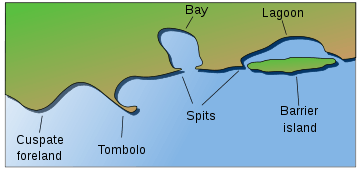Stack (geology)

A stack or seastack is a geological landform consisting of a steep and often vertical column or columns of rock in the sea near a coast, formed by erosion.[1] Stacks are formed over time by wind and water, processes of coastal geomorphology.[2] They are formed when part of a headland is eroded by hydraulic action, which is the force of the sea or water crashing against the rock. The force of the water weakens cracks in the headland, causing them to later collapse, forming free-standing stacks and even a small island. Without the constant presence of water, stacks also form when a natural arch collapses under gravity, due to sub-aerial processes like wind erosion. Stacks can provide important nesting locations for seabirds, and many are popular for rock climbing.
Isolated steep-sided, rocky oceanic islets, typically of volcanic origin, are also loosely called "stacks" or "volcanic stacks".
Formation
Stacks typically form in horizontally-bedded sedimentary or volcanic rocks, particularly on limestone cliffs. These rock types' medium hardness means medium resistance to abrasive and attritive erosion. A more resistant layer may form a capstone. (Cliffs with weaker rock - such as clay - tend to slump and erode too quickly to form stacks, while harder rocks such as granite erode in different ways.)
The formation process usually begins when the sea attacks small cracks in a headland and opens them. The cracks then gradually get larger and turn into a small cave. When the cave wears through the headland, an arch forms. Further erosion causes the arch to collapse, leaving the pillar of hard rock standing away from the coast - the stack. Eventually, erosion will cause the stack to collapse, leaving a stump. This stump usually forms a small rock island, low enough for a high tide to submerge. There are other stages after this.
Some stacks last for a very long time - possibly because they do not get submerged easily.
Other languages
The term kekur (Russian: кекур) is used for the stacks in the Arctic and Pacific oceans, in the Russian Far East, and for stone columns in the watersheds of the Lena, Yana and Indigirka Rivers.[3]
The Swedish rauk refers to a stone column created by natural erosion. Examples are found on the islands of Gotland, Fårö and Öland.


Examples
Asia
- Po Pin Chau, High Island, Hong Kong
- Tri Brata and Sail Rock, Russia
- Ko Tapu, Phang Nga Bay, Thailand
- Bako National Park, Sarawak, Borneo, Malaysia
- Lot's Wife or Sofugan, Japan (isolated volcanic stack, not a coastal stack)
Australia
- Ball's Pyramid, Lord Howe Island Group (isolated volcanic stack, not a coastal stack)
- Nobby Islet, Kangaroo Island, South Australia
- The Twelve Apostles (Victoria) on the Great Ocean Road, Victoria, Australia
- The Nobbies On Phillip Island, Victoria, Australia
- The Totem Pole in Tasmania
Europe
(coastal countries only)
France
- Étretat, Seine-Maritime
- Les Jumeaux, Hendaye
Faroe Islands
Germany
Iceland
Italy
- Faraglioni, Capri
- Baia dei Mergoli, Mattinata, southern Italy
- Torre Sant'Andrea, southern Italy
- Acitrezza, Sicily
- Isola del Giglio, Tuscany
- Nebida and Masua, Iglesias, south-western Sardinia
- Scoglio dell'Ulivo, Palmi
Ireland
- Branaunmore, Cliffs of Moher, Ireland
- Dun Briste Sea Stack, Ballycastle, Co. Mayo
Spain
United Kingdom
- Old Man of Hoy, Orkney, Scotland
- Old Harry Rocks, Dorset, England
- The Needles, Isle of Wight, England
- Am Buachaille, Sutherland, Scotland
- Old Man of Stoer, Scotland
- Stac an Armin and Stac Lee, St Kilda, Scotland
- Stac Dhomnuill Chaim, Lewis, Scotland
- Yesnaby Castle, Orkney, Scotland
- Sugarloaf Rock, Isle of Man
- Rockall, North Atlantic (isolated volcanic stack, not a coastal stack)
- Duncansby Stacks, Caithness, Scotland
North America
Canada
- The Big Flowerpot, Flowerpot Island, Lake Huron
- Three Sisters, Eatonville, Nova Scotia
- Percé Rock, Percé, Quebec
- Hopewell Rocks, Hopewell Cape New Brunswick
- Siwash Rock, Vancouver, British Columbia
USA
- Goat Rock, California
- Sugar Loaf, Mackinac Island, Michigan
- Turnip Rock, Michigan
- Haystack Rock, Cannon Beach, Oregon
References
| Wikimedia Commons has media related to Geological stacks. |
- ↑ Easterbrook, D.J. "Surface Processes and Landforms", p. 442, Prentice Hall, Upper Saddle River, New Jersey, 1999.
- ↑ "Sea stacks" britannica.com
- ↑ Cловарь по естественным наукам. Кекур
- ↑ Geography and Geology, Lord Howe Island Tourism Association. Retrieved on 2009-04-20.


